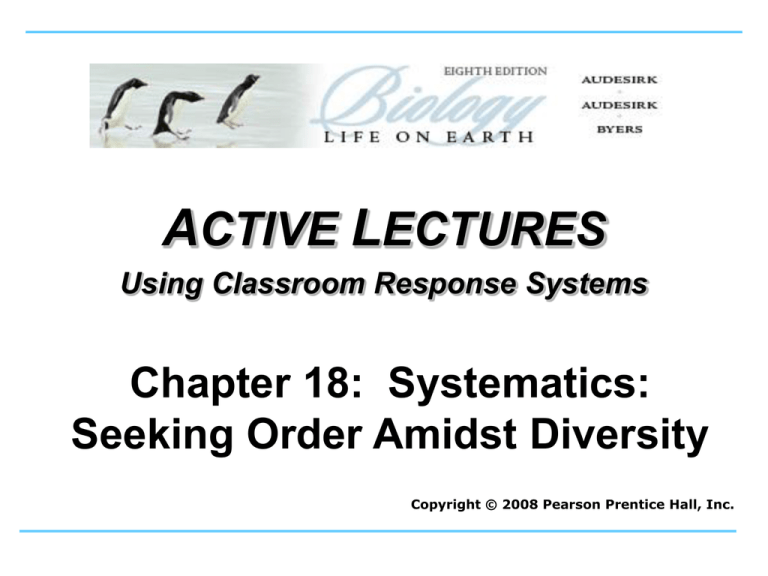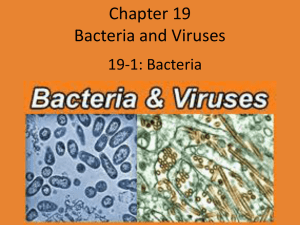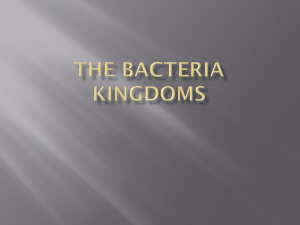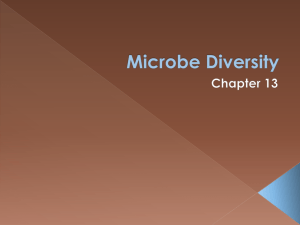
ACTIVE LECTURES
Using Classroom Response Systems
Chapter 18: Systematics:
Seeking Order Amidst Diversity
Copyright © 2008 Pearson Prentice Hall, Inc.
Which of the following is the correct order, from
most inclusive to least, of the eight major categories
of classification?
1.
2.
3.
4.
Kingdom, class, order, phylum, genus, species, domain,
family
Species, genus, family, order, class, phylum, kingdom,
domain
Domain, kingdom, phylum, class, order, family, genus,
species
Phylum, order, family, genus, kingdom, species, domain,
class
Which of the following is the correct order, from
most inclusive to least, of the eight major categories
of classification?
1.
2.
3.
4.
Kingdom, class, order, phylum, genus, species, domain,
family
Species, genus, family, order, class, phylum, kingdom,
domain
Domain, kingdom, phylum, class, order, family, genus,
species
Phylum, order, family, genus, kingdom, species, domain,
class
Which of the following is the largest and most
inclusive category?
1.
2.
3.
4.
Genus
Order
Family
Class
Which of the following is the largest and most
inclusive category?
1.
2.
3.
4.
Genus
Order
Family
Class
Which of the following is the smallest and least
inclusive category?
1.
2.
3.
4.
Genus
Phylum
Species
Family
Which of the following is the smallest and least
inclusive category?
1.
2.
3.
4.
Genus
Phylum
Species
Family
Which scientific name is written correctly?
1.
2.
3.
4.
5.
Homo Sapien
Trichechus manatus
pandinus imperator
Anolis Carolinensis
daphnia magna
Which scientific name is written correctly?
1.
2.
3.
4.
5.
Homo Sapien
Trichechus manatus
pandinus imperator
Anolis Carolinensis
daphnia magna
The forelimbs of the bird, seal, and human provide
evidence that these organisms evolved from a
common ancestor. These structures are:
1. Homologous.
2. Vestigial.
3. Analogous.
Question 18-7
The forelimbs of the bird, seal, and human provide
evidence that these organisms evolved from a
common ancestor. These structures are:
1. Homologous.
2. Vestigial.
3. Analogous.
Which of the following is not one of the three major
domains?
1.
2.
3.
4.
Archaea
Eukarya
Monera
Bacteria
Which of the following is not one of the three major
domains?
1.
2.
3.
4.
Archaea
Eukarya
Monera
Bacteria
Question 18-10
ACTIVE LECTURES
Using Classroom Response Systems
Chapter 19: The Diversity of
Prokaryotes and Viruses
Copyright © 2008 Pearson Prentice Hall, Inc.
What makes the Anthrax bacterium a good
biological weapon?
1.
2.
3.
4.
It is easy to acquire.
It is inexpensive and easy to grow.
It is easily spread.
It can easily come in contact with many people at
once.
5. It is difficult to get rid of, once distributed.
6. All of the above.
What makes the Anthrax bacterium a good
biological weapon?
1.
2.
3.
4.
It is easy to acquire.
It is inexpensive and easy to grow.
It is easily spread.
It can easily come in contact with many people at
once.
5. It is difficult to get rid of, once distributed.
6. All of the above.
Which of the following is not one of the most
common shapes of bacteria?
1.
2.
3.
4.
Rod
Round
Rectangular
Helix
Which of the following is not one of the most
common shapes of bacteria?
1.
2.
3.
4.
Rod
Round
Rectangular
Helix
Which of the following is the most important reason
to brush your teeth every day?
1. It freshens your breath.
2. It takes the bad taste out of your mouth.
3. It eliminates harmful archaea that form endospores
on your teeth.
4. It eliminates harmful bacteria that form biofilms on
your teeth.
Which of the following is the most important reason
to brush your teeth every day?
1. It freshens your breath.
2. It takes the bad taste out of your mouth.
3. It eliminates harmful archaea that form endospores
on your teeth.
4. It eliminates harmful bacteria that form biofilms on
your teeth.
Anthrax bacteria are good candidates for biological
weapons because they form:
1.
2.
3.
4.
Biofilms.
Endospores.
Colonies.
Chains.
Anthrax bacteria are good candidates for biological
weapons because they form:
1.
2.
3.
4.
Biofilms.
Endospores.
Colonies.
Chains.
Why do prokaryotes evolve at a faster rate than
humans do?
1. Prokaryotes have more DNA to mutate.
2. Prokaryotes reproduce at a faster rate.
3. Prokaryotes encounter more environmental
mutagens.
4. Because prokaryotes are smaller, they are more
prone to mutations.
Why do prokaryotes evolve at a faster rate than
humans do?
1. Prokaryotes have more DNA to mutate.
2. Prokaryotes reproduce at a faster rate.
3. Prokaryotes encounter more environmental
mutagens.
4. Because prokaryotes are smaller, they are more
prone to mutations.
In binary fission, an exact genetic copy of the parent
bacterium is produced. Aside from mutation, how
can bacterial resistance be passed from one
bacterium to another?
1.
2.
3.
4.
Sexual reproduction
Asexual reproduction
Conjugation
Photosynthesis
In binary fission, an exact genetic copy of the parent
bacterium is produced. Aside from mutation, how
can bacterial resistance be passed from one
bacterium to another?
1.
2.
3.
4.
Sexual reproduction
Asexual reproduction
Conjugation
Photosynthesis
All bacteria are pathogens, but not all pathogens are
bacteria.
1. True
2. False
All bacteria are pathogens, but not all pathogens are
bacteria.
1. True
2. False
Without bacteria, other organisms would not be able
to live on Earth. Which of the following is not a
service that bacteria provide?
1.
2.
3.
4.
5.
6.
Digest cellulose for herbivores
Produce water to replenish freshwater reservoirs
Recycle the nutrients in waste and dead organisms
Make nitrogen available to plants and animals
Produce vitamins K and B12
Break down pollutants and clean up toxic waste
Without bacteria, other organisms would not be able
to live on Earth. Which of the following is not a
service that bacteria provide?
1.
2.
3.
4.
5.
6.
Digest cellulose for herbivores
Produce water to replenish freshwater reservoirs
Recycle the nutrients in waste and dead organisms
Make nitrogen available to plants and animals
Produce vitamins K and B12
Break down pollutants and clean up toxic waste
How is the helpful E. coli that colonizes your
digestive tract different from the pathogenic E. coli
that kills about 60 Americans per year?
1.
2.
3.
4.
They are different genetically.
One is prokaryotic; the other is eukaryotic.
One can form an endospore; the other cannot.
One has flagella; the other does not.
How is the helpful E. coli that colonizes your
digestive tract different from the pathogenic E. coli
that kills about 60 Americans per year?
1.
2.
3.
4.
They are different genetically.
One is prokaryotic; the other is eukaryotic.
One can form an endospore; the other cannot.
One has flagella; the other does not.
Viruses have which of the following characteristics
of living things?
1.
2.
3.
4.
5.
6.
7.
Living things are organized.
Living things respond to stimuli.
Living things maintain homeostasis.
Living things need energy.
Living things grow.
Living things reproduce and develop.
Living things evolve.
Viruses have which of the following characteristics
of living things?
1.
2.
3.
4.
5.
6.
7.
Living things are organized.
Living things respond to stimuli.
Living things maintain homeostasis.
Living things need energy.
Living things grow.
Living things reproduce and develop.
Living things evolve.
What are viruses made of?
1.
2.
3.
4.
5.
Hereditary material and a phospholipid membrane
Hereditary material and a protein coat
Mitochondria, cytoplasm, and DNA
Chloroplasts, DNA, and RNA
A cell membrane and mitochondria
What are viruses made of?
1.
2.
3.
4.
5.
Hereditary material and a phospholipid membrane
Hereditary material and a protein coat
Mitochondria, cytoplasm, and DNA
Chloroplasts, DNA, and RNA
A cell membrane and mitochondria
With only two major components, how do viruses
stay in existence?
1. They can regenerate through their own cellular
mechanisms.
2. They always infect bacteria and the bacteria infect
other organisms.
3. They cause other organisms to evolve quickly.
4. They hijack their host’s cells for replication.
With only two major components, how do viruses
stay in existence?
1. They can regenerate through their own cellular
mechanisms.
2. They always infect bacteria and the bacteria infect
other organisms.
3. They cause other organisms to evolve quickly.
4. They hijack their host’s cells for replication.
Question 19-15
Why are viral infections difficult to treat?
1. Many viruses evolve so quickly that they become
resistant to antibiotics.
2. Viral infections always directly attack the immune
system.
3. Viruses evolve quickly and develop resistance to
antiviral drugs.
4. Viruses evolve so quickly that viral DNA switches to
RNA.
Why are viral infections difficult to treat?
1. Many viruses evolve so quickly that they become
resistant to antibiotics.
2. Viral infections always directly attack the immune
system.
3. Viruses evolve quickly and develop resistance to
antiviral drugs.
4. Viruses evolve so quickly that viral DNA switches to
RNA.
Why do you need to get a flu shot every year?
1.
2.
3.
4.
The effects of the flu shot wear off after a year.
The flu virus infects a bacterium, which mutates and
changes the DNA of the virus.
The DNA of the flu bacteria mutates and evolves
every year, rendering last year’s flu shot useless.
The DNA of the flu virus mutates and evolves every
year, rendering last year’s flu shot useless.
Why do you need to get a flu shot every year?
1.
2.
3.
4.
The effects of the flu shot wear off after a year.
The flu virus infects a bacterium, which mutates and
changes the DNA of the virus.
The DNA of the flu bacteria mutates and evolves
every year, rendering last year’s flu shot useless.
The DNA of the flu virus mutates and evolves every
year, rendering last year’s flu shot useless.
What is the difference between viroids and prions?
1.
2.
3.
4.
Viroids consist of protein only.
Prions consist of hereditary material only.
Viroids consist of hereditary material only.
Prions consist of protein only.
What is the difference between viroids and prions?
1.
2.
3.
4.
Viroids consist of protein only.
Prions consist of hereditary material only.
Viroids consist of hereditary material only.
Prions consist of protein only.










